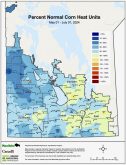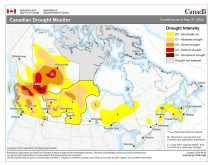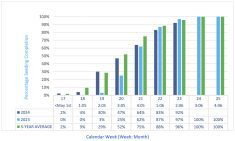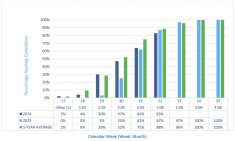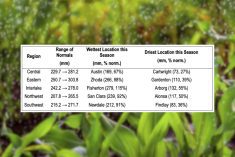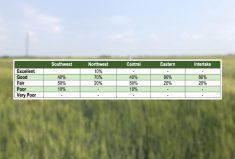Southwest Region
Very warm days, well above seasonal norms advanced harvest rapidly this week. Temperatures were extremely variable, with daytime highs ranging from the 25 C to 29 C, while overnight lows dipped to 3.5 C, with reports of frost in some northern areas. Average daily temperatures range from 11 C to 14 C. Dry and breezy days making harvest easy, excepting green regrowth or weeds in late canola and soybeans. Corn and sunflower harvest has begun ahead of schedule. Canola and soybean harvest continues; many producers are finished cereals. Significant progress has been made on fall tillage, with the first (light) pass over the land complete on many acres.
Harvest is estimated at 75 to 80% complete. Spring wheat harvest for many in the region is complete; overall completion sits at 98%. Yields have generally been good; straw has been baled immediately following cereal harvest. Most bales have been picked up, allowing for fall tillage operations. Some post- harvest weed spraying is also occurring. Barley and oat harvest is also complete. Some growers are green feeding some of the growth in oats, which has headed out again.
Read Also

Manitoba sclerotinia picture mixed for 2025
Variations in weather and crop development in this year’s Manitoba canola fields make blanket sclerotinia outlooks hard to pin down
Canola harvest is estimated at 85 to 90% complete. Yields range from 30 to 45 bu/ac; with average yields expected to be in the upper thirties. Some reports of regrowth in standing canola fields. Flax harvest continues, with yields ranging from 20 to 25 bu/acre.
Most soybeans are at R8 stage. Harvest progress is estimated at 55 to 60% complete, with some producers just starting and others finished. Early yields reported in the 30 to 45 bu/ac range. Average is expected to end up close to 35 bu/acre. Most sunflowers are at R9. Some producers are planning desiccation in coming days. Corn silage chopping continues, with some areas complete. Yields are variable, dependent on rainfall amounts through the growing season. Grain corn is at R5 stage, harvest may start in the week ahead. Leaf browning is evident.
Fall fieldwork is ongoing; harrowing whole fields and working up dried out sloughs. Lot of producers cutting hay in sloughs that have not been touched in years and quality will be marginal. Lots of straw has been baled as producers are trying to get up many different feed sources. Second cut on alfalfa stands is being done. Dugouts are approximately at 60% capacity. Cattle are in fall grazing areas. Lack of rain starting to show again. Alfalfa regrowth has stalled due to lack of moisture despite the nice weather.
Northwest Region
Another week of no precipitation and good weather allowed harvest to progress nicely across the region. However, the lack of precipitation continues to deplete soil moisture conditions and water sources.
Some post harvest fieldwork has been done; however, some are holding off due to dry conditions. Post-harvest weed control is taking place as weeds and volunteers are actively growing. The Roblin, Inglis, and San Clara areas each received a couple nights of light frosts with Inglis reaching -2 C.
Spring wheat is 99% harvested, while some oats remain standing and ready to be harvested.
Canola is 95% harvested across the region, with varying yields being reported reflective of crop conditions. Harvest progress is slightly lower in The Pas. Canola that is still standing is either late germinating/reseeded and is not quite ready for harvest. Yields in the Swan Valley in poorer crops are approximately 15 to 25 bu/ac and better crops yielding 45 to 50 bu/ac; yields in Roblin are near 35 bu/ac and Dauphin at 25 bu/ac and upwards to 55 bu/ac in better fields.
Soybean harvest is underway across the region, while more advanced in the southern areas. Most of the soybean crop is at R8 and continuing to ripen. Yields so far in the Dauphin region are averaging 25 to 40 bu/acre.
Flax is 50% harvested, no reported yields as of yet. Fababeans remain standing and continuing to ripen. Producers have wrapped up corn silaging in much of the region. Cattle feed is being hauled to winter-feeding facilities and being analyzed in order to make winter feeding plans. Grazing continues on pastures and annual fields where possible. Some producers are waiting for a frost to harvest or graze alfalfa fields. Water supply remains low and needs a good recharge for next year’s grazing season.
Central Region
South to westerly winds early to mid week have brought warmer air, pushing daytime temperatures above normal while providing good drying conditions, allowing for excellent harvest progress. Heavy to light dews arrived, depending on overnight temperatures and winds. Topsoil is drying without recent meaningful precipitation. Soil temperatures are above 10 C.
Forecast this week is for mostly sunny conditions, except for chance of rain mid-week, and above normal temperatures. No frost in the forecast. Harvest operations should progress as conditions allow.
Winter cereal planting is considered done. Earliest planted fields have emerged uniformly with the favourable topsoil moisture conditions at seeding. Staging of winter cereals depends on seeding date and varies from two to six leaves.
Field tillage continues to terminate volunteer grain growth and incorporate crop residue. First pass cultivation on cereal acres has been done on many fields. With the above normal temperatures and no frost, some post-harvest herbicide applications are still being done to control weed growth ahead of next year. Soil sampling continues on harvested fields with elevated residual nitrogen reported in general. Livestock manure application to fields is being done as harvest progressed.
Canola harvest is now considered done except for the odd field. Flax harvest is almost done and should wrap up this week. Flax straw is mostly managed via burning.
Desiccation of sunflower fields is wrapping up and harvest is expected to start next week for the earliest fields. Industrial hemp harvest is underway but no yield reports at this time.
Corn harvest has begun as stands are maturing. Corn stalks are still on the green side and would benefit from a killing frost to speed up drying. Early yield reports on early season hybrids are below average in the Red River Valley in the 60 to 70 bu/ac range, but other better-looking stands should perform better. Some grain corn is being harvested as silage for livestock feed.
Soybeans harvest progressed well with about 80 to 85% done. Reported yields range from 30 to 40 bu/ac in areas with better moisture conditions during the season but only 12 to 15 bu/ac reported in the driest fields. Green spots within fields are reported and appear to be related to moisture stress conditions experienced during the season.
Dry edible beans harvest of early maturing types is considered done while the later maturing should be done this week. Reported yields are in the 1,000 to 1,200 lbs/ac in moisture-limited areas and up to 1,600 lbs/ac in better area. In some fields, late season weed growth is requiring desiccation before harvesting the mature beans.
Potato harvest is in full swing with about 75 to 80% of the crop harvested in the Portage to Carman and Winkler areas. Western region harvest progress is higher with about 90% complete and harvest expected to continue this week with some growers finishing up. Generally, yields are slightly below average to average.
Annual crop regrowth is being cut in places for livestock feed or grazed.
Producers are testing cereals and canola regrowth for nitrates as levels have been higher than normal due to elevated soil residual nitrogen. Corn silage harvest is underway with yields half to two- thirds of normal. Some grain corn is being harvested as silage.
Second cut alfalfa has regrown and will be grazed or cut for hay close to a frost. Some third cut has already been baled. Extra straw and wild hay has been baled for livestock feed. Pastures have regrown to provide sufficient fall grazing but are slowing down where conditions are drier. Overall winter feed supplies will still be short or tight for many producers.
Water availability is better but surface supply and quality is still low and will require recharging for next year.
Eastern Region
Trace amounts of rainfall this week across the northern parts of the region, while temperatures began ranged from seasonal to above seasonal. Some northern parts of the region experienced a light frost early Monday morning, seeing temperatures as low as -2 C. No grower concerns resulted, since crops are generally mature. Rapid harvest progress was made this week, particularly with soybeans. Lots of field work and fertilizer application was completed as well. Higher than normal soil temperatures has delayed anhydrous ammonia applications and there is expected to be a rush on this work once things cool down. Some farms have completed their harvest for the year, or are waiting on sunflowers and corn and are all caught up otherwise. Most growers are working on their soybeans and a few remaining canola fields.
Canola harvest is essentially complete except for a few reseeded crops. Canola yield reports range from 10 to 40 bu/ac with the average being around 20 to 25 bu/acre. Canola yielded better than expected, however expectations were low due to the growing season’s moisture deficit.
Flax harvest and straw baling is nearly complete with yields in the 20 bu/ac range. Below average yields were expected given how poorly the crop handled drought stress.
Sunflowers were at R9 (bracts yellow or brown, physiological maturity). Desiccation is completed and sunflowers continue to dry down rapidly. Producers have noted that sunflower and corn harvests may end up overlapping this year.
Soybean harvest is about 50% done with yields ranging from 19 to 42 bu/ac with good quality. Average yield for the region will likely be between 30 to 35 bu/acre. A few soybean fields are still drying down. Rapid progress on remaining acres will occur this week if the weather cooperates. Producers pushing very hard on harvesting this crop as some rain is in the forecast.
Grain corn crops have achieved black layer indicating physiological maturity and continue to dry down rapidly. Grain corn vegetation was also quickly turning colour. Yield expectations are lower than average with some interest in ensiling the crop rather than taking it for grain, to help address feed shortages in the region.
Second cut and third cut continued for beef producers with a very wide range in progress and will be ongoing over the coming weeks. Corn silaging is about 70% done. Delays are arising, as some fields are slow to dry. Kernels are dry but plant material has not dried down sufficiently for quality silage. Producers are also taking opportunities to bale up any extra forage they can find, taking advantage of current weather conditions. Warm weather has spurred enough regrowth in some harvested oat fields to justify cutting and baling up the regrowth. Producers are being very innovative in their effort to ensure they have sufficient feed supplies for the winter.
Interlake Region
Favourable weather has allowed harvest to progress, with a large jump in soybean harvest completion. No hard frosts have meant that many cereal and canola stubble fields have green regrowth, competing for moisture and nutrients from the 2022 crop. Regrowth on oat, barley, and wheat fields has warranted cutting as silage or greenfeed in many cases. Yellow canola fields are causing major problems trying to take the last of the canola crop off amongst green leaves and flowers, or even where desiccants were applied and crop has not died back. Some canola regrowth is being put to use as alternate cattle forage.
Soybean harvest has advanced to 15% complete in the Arborg area, while 25% complete in the south Interlake. Yields range from 20 to 40 bu/ac, averaging close to the middle of that range.
Some late remaining unharvested spring wheat near Arborg is sprouting in the swath, and the few unharvested wheat acres are feed grade, compared to earlier harvested No 1 grade.
Desiccation finished on many flax crops; reported yields are approximately 15 bu/acre.
Forage seed crops are generally yielding about half of normal, while older stands are in poorer condition than recently renovated forages. Alfalfa seed harvest is between 70 to 90% complete. Yields are widely variable, from zero to 300 lbs/ac, averaging 80 lbs/acre. Many fields in the Fisher Branch to Moosehorn area ended up as feed instead of planned seed production due to severe livestock feed shortages. Timothy seed yields are averaging 125 lbs/ac, while meadow fescue stands are going between 200 to 300 lbs/acre, if kept for seed yield and not cut for hay.
Winter cereal planting is complete; hybrid fall rye remains the crop of choice, with a 10% increase in acres over 2020. Fall fieldwork is variable, with some fields in the south Interlake tilled or disked as in a normal year, while others are left as standing stubble to trap snow and improve soil moisture conservation for the 2022 crop.
Corn silage harvest is underway, with reported yields from 2.5 to 10 tonnes/acre. Most crops are averaging close to 5 tonnes/acre. Winter-feed supplies for cattle producers sits at approximately 70% secured in the south Interlake.
Rains in mid August temporarily increased dugout water levels, which have now begun to decline once again. New wells continue to be drilled throughout the region.






